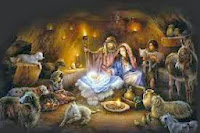Bethlehem, under starlit skies, animals helped to warm the cool, night air with
their humid breath. Sending angels as
midwives and providing a feedbox for a crib, God chose to enter our world in
flesh in blood form; the son of Mary, the son of God. It was a moment in history marked for
salvation by the Creator of everything who chose to be born with nothing.
Christmas—love, salvation, humility, our Mother Mary, and the simplicity of a
stable in Bethlehem. Who among us would
not want to be transported to such a place and such a time to catch a glimpse
of the holy moment, unencumbered by what has become the shallow trappings of
Christmas?
we can visit through the imaginings in our soul; meditating on this holy night.
The place, in the Holy Land, is still there, accepting Christian travelers
desiring to touch the physical world Jesus Christ was born into and to be
touched by him.
deep in my heart and meditations and, yet, while I want to be there, I do not
want to go there. My stay-at-home life draws me to stay at home, at least at
this time. But I still move closer to
Christ and the first Christmas by knowing that the physical world he created
and chose to live in, still exists. And I content myself with traveling the way
I do best, through books.
have taken a Christmas pilgrimage through The
Holy Land: An Armchair Pilgrimage by Fr. Mitch Pacwa, S.J. With reflections and pictures of Gospel
lands, Pacwa has led me from the comfort of my home just as he has led fifty-eight
pilgrimages to Israel.
includes many of the places associated with the life and death of Jesus, but
for Advent, it is the chapter on Bethlehem that I reflect upon. My command of
geography and history is no command at all, so I am part inspired and part
amazed to realize the extent of preservation from the life of Jesus. Inside the Church of the Nativity, there is a
marble and limestone entrance and stairs that lead to the cave where Jesus was
born. In this cave is an altar built over
a silver star embedded in the floor that marks the spot of Christ’s birth. The
place of his birth is a physical place that exists through time–from his birth
until today.
that during the time of Christ, stone mangers were common. “Two stone mangers
were found within this cave by St. Helena; one was taken to Rome and one
remains,” he wrote. “At Midnight Mass on
Christmas Eve, the Latin Patriarch of Jerusalem places an image of the Christ
Child in this manger, where it remains until the Epiphany.
chapter is the commemoration of the Visitation. This was the time when Blessed
Virgin Mary visited her cousin Elizabeth while both were pregnant; one with our
Savior and the other with the herald of the Savior, John the Baptist. The church there contains the well, where by
tradition, Mary met Elizabeth. Caves
such as shepherds used to protect their sheep, amid hills and fields surround
Bethlehem and give testimony of the simplicity of those who first received the
Good News. The book includes the other
places that marked the Gospel events in the life of Christ, which began in
Bethlehem.
receive that same Good News Jesus brought to us and to live it out. To do so
demands that I leave my modern life of comfort and conveniences and contemplate
the fullness of Christ’s message to us. Gazing on the world he was born into
magnifies his testimony. It is holy
preparation for such a holy time as Christmas.
————————————————————————————
For more inspiration, check out: Big Hearted: Inspiring Stories From Everyday Families a collection of stories on love and life, and Dear God, I Don’t Get It, children’s fiction that presents faith through a fun and exciting story.Follow Patti at Twitter and like her Facebook pages at Dear God Books, Big Hearted Families, A GPS Guide to Heaven and Earth









